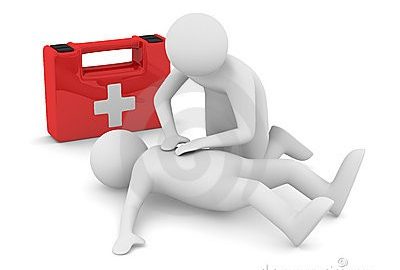Consider this scenario: Its Christmas time and you’ve decided to put up Christmas lights around the front of your home. You are home with your six year old son and eight year old daughter. As you gather the lights and hanging materials, you realize you will need to use a ladder to securely fasten the lights to the trim and gutters surrounding the front of your home. As you get to the last section of lights to hang, the ladder wobbles and you fall to the ground…onto an exposed rock which causes you to lose consciousness and lacerate your head. Would your children know what to do to help potentially save your life?
When faced with a possible scenario like this, we would like to think that our children would know to call 9-1-1 and ask for help, but what if the injuries were more severe? What if, instead of a rock, you had fallen on a rake and suffered puncture wounds? Would a child know what to do then? Are children ages six and eight even able to comprehend what steps need to be taken in order to help save you? I would suggest that they are, and should be given the opportunity to learn certain life-saving skills.
In a January 2019 article published in the United Kingdom, it was shared that beginning in 2020, schools will require students to learn CPR, the purpose of defibrillators or AEDs, and basic treatments for common injuries. It was noted in the article that cardiac arrest survival rates in countries which taught CPR in school were double those of the United Kingdom. The hope of those who introduced this legislation was that if students learned these life-saving skills in school, they would feel more confident helping should an emergency situation occur in their proximity.
There will be those individuals who believe that children, as young as five or six years old, do not have the cognitive ability to learn sophisticated concepts such as first aid or CPR, and you would find many individuals who would support this idea. However, a study was conducted in 2014 where 315 students under the age of six years old were randomly selected to be placed into study groups. One group was trained in basic concepts of first aid, and the other group was not. The results of the study showed that very young children are able to learn and apply basic first aid skills taught to them by their teachers. Children are eager to learn, and eager to help those in need. You can see this anytime a ‘friend’ gets hurt on the playground or is sick at home. Their compassionate natures lend to their desire to help. Children are also very quick to learn new skills. Their brains are quickly able to assimilate new learning along with basic applications.
I hope that there is never a time when my son has to call 9-1-1 because I have been injured at home, but I feel better in the knowledge that should such an occasion arise, he knows how to call.
“Children to be taught lifesaving skills in school.” (Jan. 2019). Retrieved from https://www.aol.co.uk/news/2019/01/02/children-to-be-taught-lifesaving-skills-in-school/
Ammirati, Christine & Gagnayre, Rémi & Amsallem, Carole & Nemitz, B. & Gignon, Maxime. (2014). Are schoolteachers able to teach first aid to children younger than 6 years? A comparative study. BMJ open. 4. e005848. 10.1136/bmjopen-2014-005848.

I think that the statics are interesting and very strong to support the idea of teaching children first aid skills. It is a concept that people find to be scary because of the times we live in when there are so many scenarios of violence. In contrast, people do not think twice about teaching first aid to Girl/Boy Scouts because that seems to be normal and is not correlated to violent situations.
A program implemented in schools that all students and teachers prepared would be beneficial in all situations.
That is a scary scenario! Working with five and six years olds, I am aware that some of them would know what to do but others not so much. It must be taught! Parents are the key. Communication and giving them the tools they need are necessary. Teachers and group leaders can help to reinforce skills.